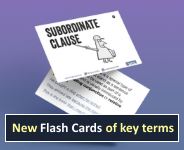Glossary: relative pronoun
Explanation
A pronoun which is used at the start of a relative clause, e.g. who, which, that (the girl who won the race, the necklace which/that I found).Englicious contains many resources for English language in schools, but the vast majority of them require you to register and log in first. For more information, see What is Englicious?

